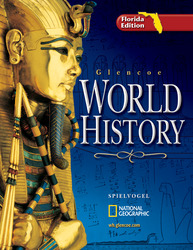Glencoe World History, Florida EditionChapter 2:
Western Asia and Egypt, 3500–500 B.C.Web Activity Lesson PlansIntroduction
Students have read about ancient Egyptian life. In this activity students
will focus on death in Egyptian religion. Archaeologists have discovered artistic
images, written inscriptions, and other artifacts alongside the mummies in Egyptian
burial tombs. By studying mummification and other burial customs, we can gain
an understanding of what ancient Egyptians believed about death and the afterlife. Lesson Description
Students will go to the Life in Ancient Egypt Web site of the Carnegie Museum
of Natural History to read about customs and beliefs relating to death. They
will answer four questions about what they have read and then write an essay,
drawing on a class discussion of the topic and their review of the web site. Lesson Objectives - Students will be able to analyze the Egyptians' rituals and customs and
their beliefs.
- Students will be able to explain ancient Egyptian burial practices.
Student Web Activity Answers - Mummification was one of the steps in ensuring that the dead entered the
afterlife. The ancient Egyptians believed that full participation in the afterlife
required that an individual's identity be preserved. Mummification helped
achieve this by preserving the body.
- Mummification could take as long as 70 days. It involved four main steps:
removing all of the internal organs except the heart, drying the body, stuffing
the body, and carefully wrapping the body.
- Scenes and inscriptions from important stories protected the spirit of the
deceased on his or her dangerous journey to the underworld.
- The Egyptians believed that after a person died, the heart was weighed against
the feather of Maat, the goddess of truth and justice, and the results were
recorded by Thoth, the god of writing. If a person had led a decent life,
the heart balanced with the feather and the person was rendered worthy to
live forever in paradise with Osiris.
- Students' papers should discuss at least three burial customs, such as the
weighing of the heart, mummification, the use of shabtis, and the use of
inscriptions and scenes on coffins and the walls of tombs. Papers should show
an understanding of burial customs and the beliefs behind those customs.
 | 






